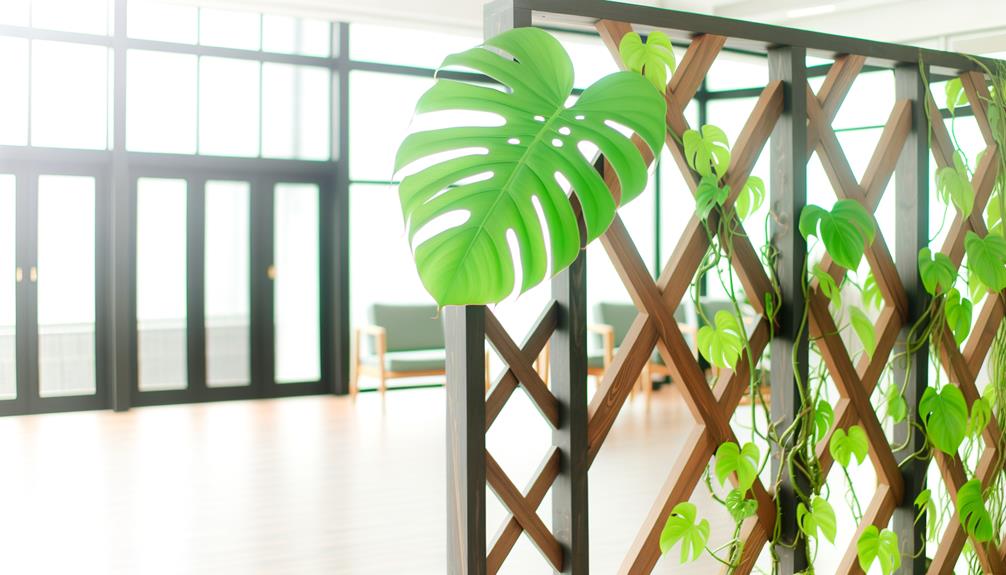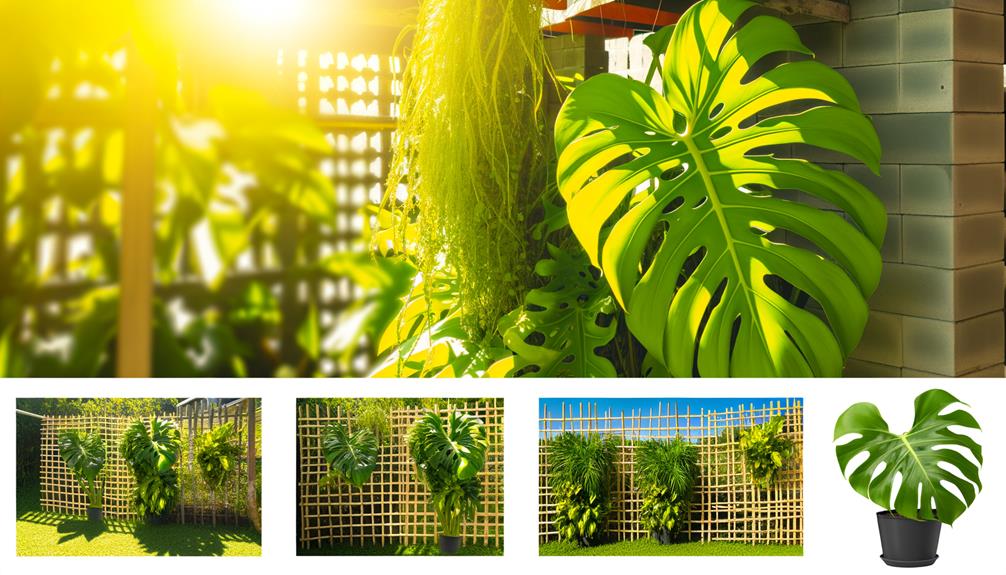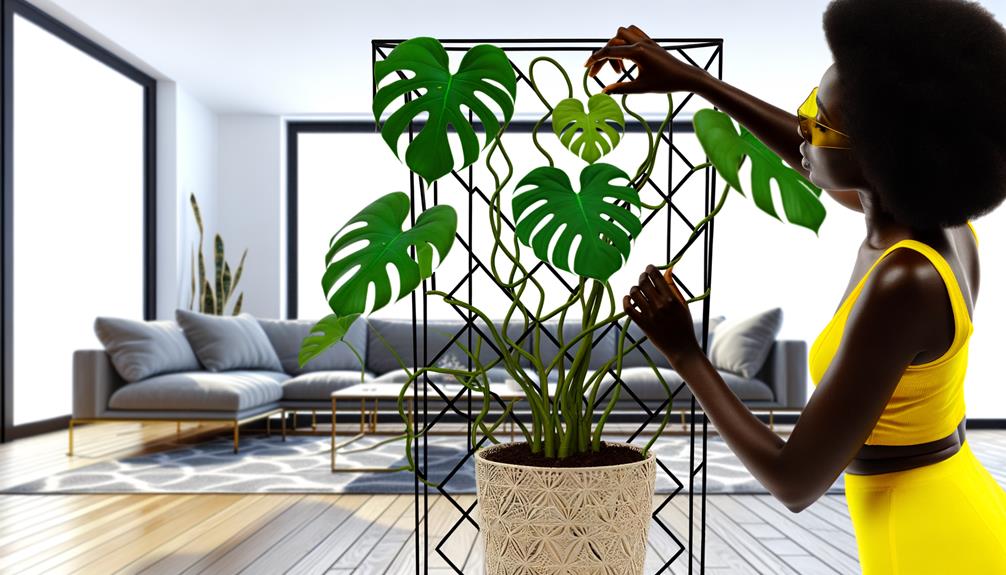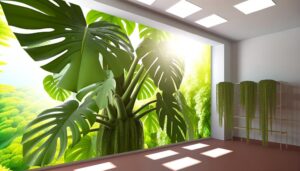Best Trellis for Monstera Deliciosa: Top Picks!
Choosing a perfect trellis for Monstera Deliciosa demands thoughtful evaluation of material, size, and installation methods. Choose wooden trellises for a natural appearance or metal trellises for durability and resilience against environmental deterioration.
Moss poles are superb for creating a moist microenvironment suitable for aerial root attachment. Guarantee that the trellis height exceeds the mature plant height, and anchor it at least 6 inches deep for steadiness.
Routine upkeep, such as trimming and examinations, ensures structural integrity and promotes vertical growth. For comprehensive information on achieving top-notch outcomes, continue to explore our guidelines.
Top 6 Trellis Options for Monstera Deliciosa

Key Takeaways
- A moss pole supports aerial roots and creates a humid microenvironment.
- Coated metal trellises offer durability and resistance to environmental degradation.
- Treated wooden trellises provide a natural appearance and fungal resistance.
- Plastic trellises are lightweight and moisture-resistant, ideal for indoor use.
- Bamboo stakes offer flexibility and ease in guiding Monstera growth.
Types of Trellises

There are several types of trellises suitable for supporting Monstera deliciosa, each varying in material composition, structural design, and functional application.
Common options include wooden trellises, which offer a natural appearance and stability; metal trellises, known for their durability and resistance to environmental degradation; and plastic trellises, favored for their lightweight and moisture-resistant properties.
Additionally, moss poles, often constructed from a core wrapped in sphagnum moss, provide a humid microenvironment conducive to aerial root attachment. Bamboo stakes, though simplistic, offer flexibility in guiding plant growth.
Each type facilitates vertical growth, optimizing light exposure and encouraging the Monstera’s characteristic fenestration. Careful selection based on specific growth conditions and aesthetic preferences can greatly enhance plant health and vigor.
Benefits of Using a Trellis
Implementing a trellis for Monstera deliciosa offers numerous benefits. The trellis provides enhanced structural support, optimized light exposure, and improved spatial management.
Utilizing a trellis system supports the plant’s natural growth habit, mitigating the risk of structural collapse due to the weight of its large, fenestrated leaves. This structural support promotes healthier growth by allowing the aerial roots to anchor more effectively.
Optimized light exposure is achieved as the trellis allows for even distribution of light across the plant’s foliage. This facilitates photosynthesis and overall vigor.
Moreover, improved spatial management is attained by guiding the Monstera’s expansive growth vertically. This conserves horizontal space and enhances its aesthetic appeal.
These advantages collectively contribute to the plant’s sustained health and ornamental value.
Material Options

Frequently, selecting the appropriate material for a trellis involves considering factors such as durability, weather resistance, and compatibility with the Monstera deliciosa’s growth characteristics. Various materials can be utilized, each offering distinct advantages.
Metal trellises, known for their strength and long-lasting nature, are ideal for supporting the weighty vines of Monstera. Wooden trellises, while visually pleasing, require treatments for moisture resistance to prevent decay.
Plastic trellises, lightweight and resistant to corrosion, provide a cost-effective solution but may lack the structural integrity for larger plants. Bamboo, sustainable and flexible, offers a natural look but may not withstand prolonged moisture exposure.
| Material | Characteristics |
|---|---|
| Metal | Strong, weather-resistant, robust |
| Wood | Aesthetic, requires treatment, prone to decay |
| Plastic | Lightweight, corrosion-resistant, cost-effective |
| Bamboo | Sustainable, natural look, less durable in moisture |
| Composite | Blend of materials, combines best traits, costlier |
Choosing the right material guarantees that the trellis supports healthy growth and longevity of the plant.
Size and Height Considerations
When selecting a trellis for Monstera deliciosa, it is important to think about the best dimensions that accommodate the plant’s natural growth patterns.
The trellis height should ideally surpass the expected mature height of the plant, which can reach up to 10-15 feet indoors.
Proper support structures must be strong enough to sustain the significant weight and extensive foliage of fully grown specimens.
Optimal Trellis Dimensions
Determining the best dimensions for a trellis supporting Monstera deliciosa involves considering both the plant’s mature size and its natural climbing behavior. A mature Monstera can reach vast heights, often spanning 10-15 feet in indoor settings.
Therefore, a trellis should ideally be at least 6-8 feet tall to accommodate vertical growth. The width of the trellis should be proportionate, generally ranging from 2-4 feet, to provide ample climbing space while maintaining structural stability.
| Feature | Ideal Dimension |
|---|---|
| Height | 6-8 feet |
| Width | 2-4 feet |
| Material | Sturdy wood/metal |
| Mesh Opening | 2-3 inches |
| Depth | 1-2 feet |
These dimensions ensure that the trellis supports the plant’s aerial roots and expansive foliage, promoting healthy growth.
Supporting Plant Growth
To support the robust growth of Monstera deliciosa, it is crucial to take into account both the plant’s ultimate size and its vertical climbing tendencies. Monstera deliciosa can reach heights of up to 10-15 feet indoors, requiring a sturdy trellis that can accommodate its weight and extensive aerial roots. The trellis should be designed to optimize the plant’s natural growth patterns.
- Material Selection: Opt for materials like moss poles or bamboo, which provide good anchorage for aerial roots.
- Height Considerations: Ensure the trellis is at least 6-8 feet tall to support mature plants.
- Stability: A wide base or secure attachment is essential to prevent tipping.
- Adjustability: Modular or extendable designs can adapt to the plant’s growth over time.
These considerations will guarantee a healthy, well-supported Monstera deliciosa.
Installation Tips

For best Monstera deliciosa support, position the trellis securely into the soil at a depth of at least 6 inches to guarantee stability and proper root integration. This guarantees the trellis can withstand the plant’s substantial growth and weight.
Use a well-draining, aerated potting mix to facilitate root expansion around the trellis base. Secure the main stem to the trellis using flexible plant ties, which should be adjusted periodically to accommodate growth. It is essential to avoid constricting the stem, which may impede nutrient flow.
Ensure the trellis is vertically aligned and positioned centrally in the pot to provide uniform support. Proper initial setup minimizes future structural adjustments and promotes ideal vertical growth and leaf development of your Monstera deliciosa.
Maintenance and Care
Proper maintenance and care of Monstera deliciosa on a trellis involve regular pruning to remove dead or damaged leaves, as well as periodic cleaning to prevent pest infestations and fungal growth.
Ensuring the structural integrity of the trellis is vital, requiring frequent inspections and adjustments to support the plant’s weight and growth patterns.
Additionally, monitoring the stability of the trellis helps in maintaining ideal vertical growth and overall plant health.
Pruning and Cleaning Tips
Pruning and cleaning your Monstera deliciosa are essential practices that promote healthy growth and prevent the accumulation of pests and diseases. Regular maintenance involves removing dead or yellowing leaves, which can otherwise harbor pathogens. Additionally, periodic pruning helps manage the plant’s size and encourages more robust leaf development.
To maintain peak plant health, follow these guidelines:
- Sterilize pruning tools: Use a solution of isopropyl alcohol to disinfect your shears before and after each use.
- Target specific areas: Focus on cutting back leggy growth and removing any damaged tissues.
- Clean leaves: Wipe the foliage with a damp cloth to remove dust and enhance photosynthesis.
- Inspect regularly: Check for signs of pests, such as spider mites or scale, and take prompt action.
These practices guarantee your Monstera remains vibrant and flourishing.
Support and Stability
Beyond pruning and cleaning, ensuring sufficient assistance and stability for your Monstera deliciosa is fundamental to its structural integrity and ideal growth. Employing a sturdy trellis enhances vertical development and prevents stem damage. Material selection is critical; opt for materials like coated metal or treated wood to resist moisture and fungal growth. Proper anchoring is essential to accommodate the plant’s increasing mass and aerial roots.
| Material | Benefits |
|---|---|
| Coated Metal | Resists moisture, durable |
| Treated Wood | Natural appearance, fungal resistance |
| Plastic Trellis | Lightweight, easy to adjust |
Regular inspection and adjustment are necessary to ensure the trellis remains secure as the Monstera expands. This support system not only preserves the plant’s aesthetic but also promotes best photosynthesis by maximizing leaf exposure.
Does Monstera Deliciosa Need A Trellis?
Yes, Monstera deliciosa benefits significantly from a trellis. As a vining plant, it naturally grows by climbing trees in its native habitat, using its aerial roots for support. Indoors, providing a trellis helps the plant grow vertically, supports its heavy stems, and prevents it from sprawling uncontrollably.
Benefits of Using a Trellis:
- Vertical Growth: Encourages the plant to grow upwards, mimicking its natural environment.
- Support for Heavy Stems: Helps manage the weight of the plant as it matures, preventing stems from breaking or sagging.
- Healthier Growth: Improves air circulation around the plant, reducing the risk of mold and pests.
Types of Trellises:
- Moss Poles: Provide a medium for aerial roots to grip, though they require consistent moisture.
- Metal Trellises: Sturdy options like the Panacea Garden Ladder offer strong support and are less maintenance-intensive than moss poles.
- Tower Trellises: Modular systems designed for robust support and easy assembly.
Overall, using a trellis is highly recommended for maintaining a healthy and aesthetically pleasing Monstera deliciosa indoors.
Conclusion
The implementation of trellises for Monstera deliciosa cultivation can greatly enhance plant health and growth. Studies indicate that vertical support structures can increase leaf size by up to 30%, optimizing photosynthesis.
Material selection, appropriate dimensions, and proper installation are critical factors in maximizing these benefits. Regular upkeep guarantees long-term efficacy.
Therefore, trellises serve as an invaluable tool in horticultural practices, promoting robust development and aesthetic appeal of Monstera deliciosa.






